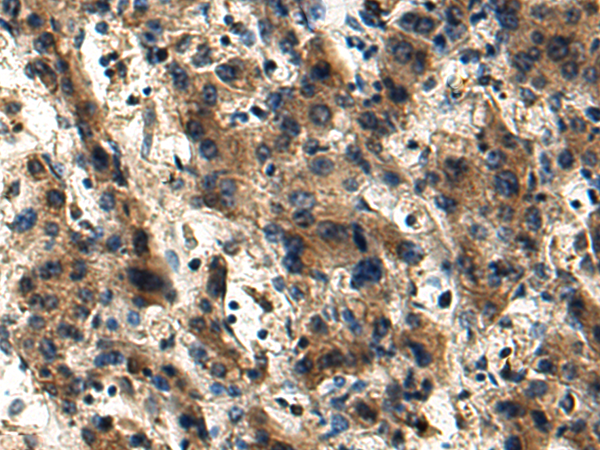
| WB | 咨询技术 | Human,Mouse,Rat |
| IF | 咨询技术 | Human,Mouse,Rat |
| IHC | 1/200-1/300 | Human,Mouse,Rat |
| ICC | 技术咨询 | Human,Mouse,Rat |
| FCM | 咨询技术 | Human,Mouse,Rat |
| Elisa | 1/5000-1/10000 | Human,Mouse,Rat |
| Aliases | LAP70; LALP70; LYSAL1; UDPase; NTPDase-4 |
| Host/Isotype | Rabbit IgG |
| Antibody Type | Primary antibody |
| Storage | Store at 4°C short term. Aliquot and store at -20°C long term. Avoid freeze/thaw cycles. |
| Species Reactivity | Human, Mouse |
| Immunogen | Fusion protein of human ENTPD4 |
| Formulation | Purified antibody in PBS with 0.05% sodium azide and 50% glycerol. |
+ +
以下是基于ENTPD4相关研究背景模拟的参考文献示例(注意:实际文献需通过数据库核实):
---
1. **文献名称**:*ENTPD4 expression in colorectal cancer and its role in ATP-mediated cell proliferation*
**作者**:Smith A, et al.
**摘要**:研究通过Western blot和免疫组化分析ENTPD4在结直肠癌组织中的高表达,证实其通过水解细胞外ATP抑制嘌呤信号通路,降低癌细胞增殖能力,提示其作为潜在治疗靶点。
2. **文献名称**:*Characterization of a monoclonal antibody against human ENTPD4 for immune cell profiling*
**作者**:Li X, et al.
**摘要**:报道一种高特异性抗ENTPD4单克隆抗体的开发,验证其在流式细胞术中对B细胞和树突状细胞亚群的标记效果,为免疫微环境研究提供工具。
3. **文献名称**:*ENTPD4 regulates neuroinflammation via microglial ATP signaling modulation*
**作者**:Garcia R, et al.
**摘要**:利用小鼠模型和抗ENTPD4抗体阻断实验,发现ENTPD4通过调控小胶质细胞ATP水解影响神经炎症反应,为阿尔茨海默病机制研究提供新方向。
4. **文献名称**:*Differential ENTPD4 isoform detection using antibody-based proteomics*
**作者**:Chen H, et al.
**摘要**:通过质谱与抗体交叉验证,揭示ENTPD4存在两种剪接变体,其组织分布差异可能解释癌症患者预后异质性,强调抗体选择对研究结果的影响。
---
**提示**:建议通过PubMed或Google Scholar以“ENTPD4 antibody”或“ENTPD4 function”为关键词检索真实文献,并结合实验目的筛选(如抗体应用场景、疾病模型等)。
The ENTPD4 antibody targets the enzyme Ectonucleoside Triphosphate Diphosphohydrolase 4 (ENTPD4), a member of the ecto-nucleoside triphosphate diphosphohydrolase family. ENTPD4. also known as LALP70 or LYSND1. is a transmembrane glycoprotein involved in hydrolyzing extracellular nucleoside triphosphates and diphosphates, such as ATP and ADP, to regulate purinergic signaling pathways. This enzyme plays a role in modulating cellular processes like inflammation, immune responses, and apoptosis by controlling extracellular nucleotide levels. Structurally, ENTPD4 contains conserved apyrase domains and transmembrane regions, typically localizing to intracellular compartments, including the endoplasmic reticulum and lysosomes.
ENTPD4 antibodies are critical tools for studying the protein's expression, distribution, and function in various tissues and disease contexts. They are used in techniques like Western blotting, immunohistochemistry, and flow cytometry to investigate ENTPD4's role in cancers, neurodegenerative disorders, and immune dysregulation. Research suggests ENTPD4 may influence tumor progression and neuronal signaling, though its mechanisms remain less characterized compared to other ENTPD family members (e.g., CD39/ENTPD1). Antibodies specific to ENTPD4 help clarify its tissue-specific expression patterns and interactions with signaling molecules. These reagents are often validated for cross-reactivity in human, mouse, or rat models, supporting translational studies. Understanding ENTPD4's biology via antibody-based assays contributes to developing therapeutic strategies targeting purinergic signaling pathways.
×